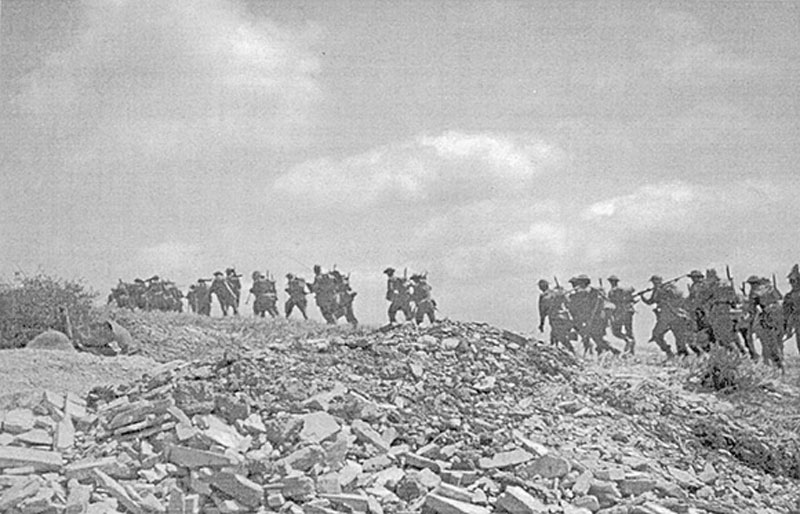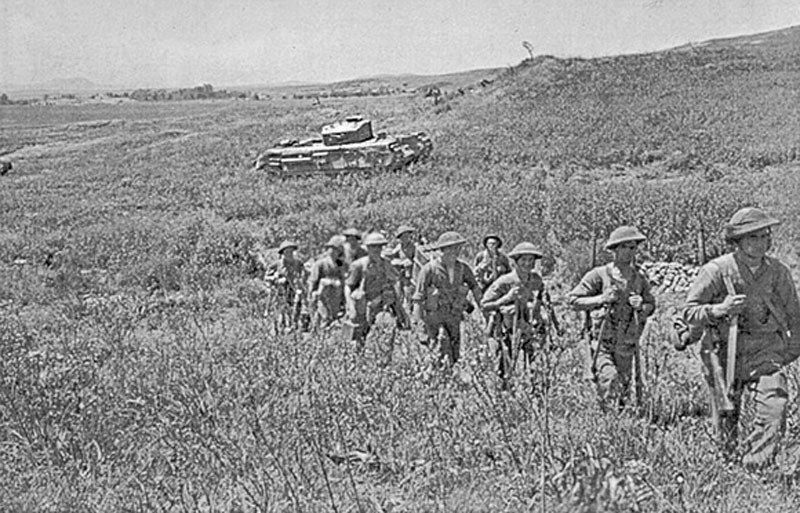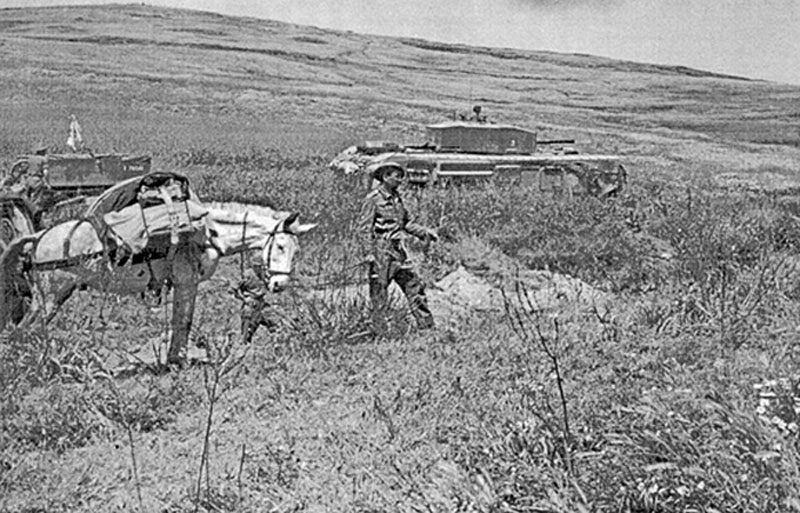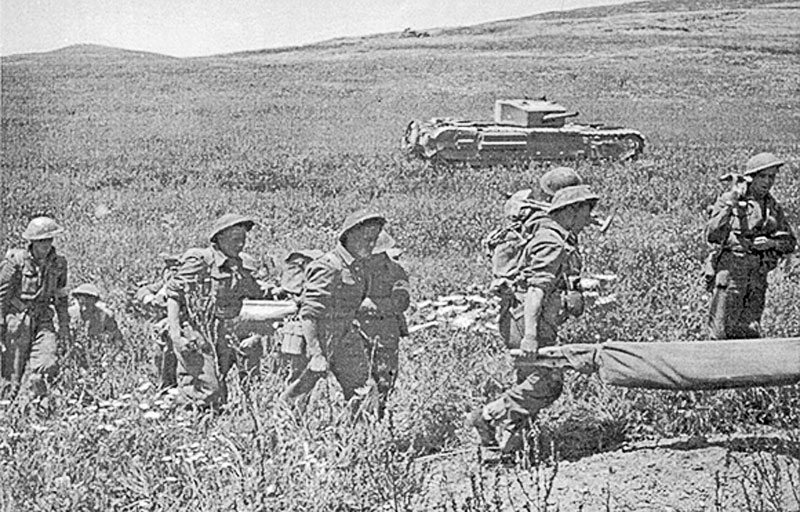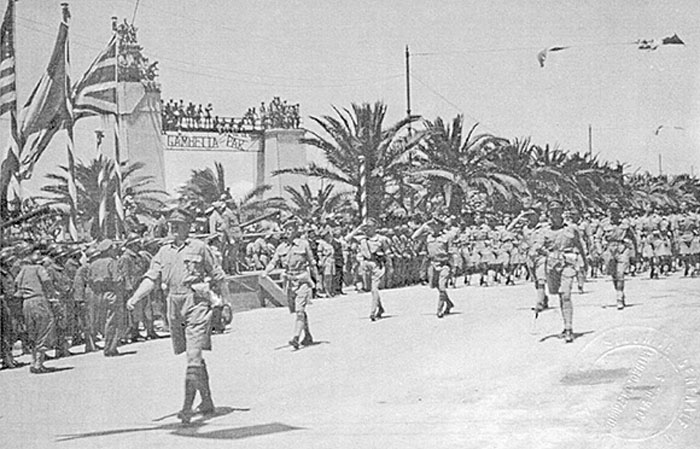1st Battalion
Spring Battle of the Peaks
Chapter 6
78 Division plan for the offensive was to attack northwards across the Beja-Oued Zarga-Medjez road and capture the high ground to the north west of the Medjez-Tunis road. This mountain country has been described by General Anderson himself as "a vast tract of country, every hill in which is large enough to swallow up a brigade of infantry, where consolidation on the rocky slopes is very difficult, in which tanks can only operate in small numbers, where movement of guns and vehicles is very restricted, and where the Division had to rely on pack mules for its supplies and to carry wireless sets, tools and mortars. The general impression is one of wide spaciousness - a kind of Dartmoor, or Central Sutherlandshire, but with deeper valleys and steeper hills".
General Evelegh, Commander of 78 Division, decided that all three brigades should attack together. 11 Brigade was on the right having assembled south of Djebel Touila; 36 Brigade in the centre and 38 (Irish) Brigade on the left. 38 (Irish) Brigade had joined 78 Division in March 1943 as replacement for 1 Guards Brigade which had become the Lorried Infantry Brigade of 6 Armoured Division. 11 Brigade plan provided for a two battalion attack by 5 Northamptons and 1 Surreys with 2 Lancashire Fusiliers in reserve.
At 0400 hours on 7th April, 1 Surreys crossed the start line, which was the Oued Zarga-Medjez road behind a heavy artillery barrage with three companies up - A Company (Captain E H Giles, MC.,), B Company (Captain R C Taylor) and C Company (Major W D Caffyn). A and B Companies reached their first objective by 0430 hours while it was still dark without opposition. C Company, however, met strong opposition and after a brisk fight secured its first objective and captured a good haul of prisoners. In the fighting C Company lost three officers and many Other Ranks. Major Caffyn was taken prisoner, but later escaped in Italy. While on their objectives the companies came under heavy mortar fire but held on to their positions. In the morning of 8th April A Company made an attack on the next enemy position and took 90 prisoners and the other companies advanced and occupied the Berber village of Toukabeur. The signal 'Touk is took' was sent to Brigade Headquarters. On this day Lieut G D Botterell was wounded when his carrier was blown up by a mine. The next day 1 Surreys with 2 Lancashire Fusiliers and supported by tanks occupied Chaouach. On this occasion Band C Companies captured 128 prisoners. For the next few days the Battalion consolidated in its defensive positions. It was not attacked but was shelled continuously.
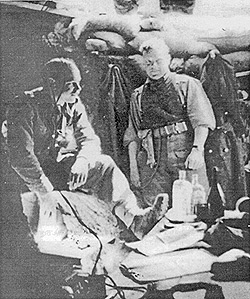 |
| Captain R C Taylor and another in B Coy dugout |
11 Brigade was next engaged in heavy fighting for Djebel Tanngoucha and Djebel Ang, 3000 foot ridges that overlooked Longstop Hill and Medjez. Dudng the night of 13/14th April, 1 Surreys launched an attack on Djebel Ang. The Battalion for this attack was commanded by Major H B L Smith, as Lt Col Wilberforce was LOB (Left Out of Battle). It was an attack behind an artillery barrage. A and B Companies gained their objectives on part of Djebel Ang despite strong opposition, but Battalion Headquarters and C Company following up had the misfortune to walk into a German Defensive Fire Task which caused a number of casualties and stampeded the mules carrying wireless sets and other heavy equipment. Rounding up the mules was a difficult task in the dark and it was some time before communications with Brigade and the forward companies could be restored.
Among the wounded were Captain H F Payne (Adjutant), Captain K N Plater (Signals Officer), and Lieut D C Foster (Mortar Officer). The enemy who were still on part of Djebel Ang counter-attacked very strongly and recaptured it. A further attack was made and the feature, captured for a second time, was now held. During the attack Sergeant T W Straight (Mortar Platoon) lost his way and suddenly found himself at a dug-out containing six Germans. He shot one and took the rest prisoner. For his leadership in this action Major Smith was awarded the Military Cross.
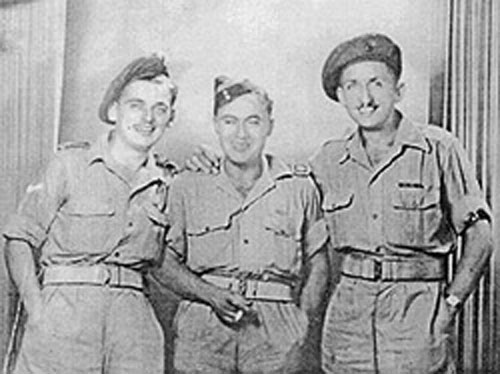 |
| Pictured left to right: L/Cpl G Veasey; L/Cpl G Cook; Pte A W G Martin, MM |
By 16th April Medjez was free from any real threat from the hills and now First Army was able to build up there the stores, ammunition and forces needed for the final thrust. In General Anderson's words all this "had been achieved by units which had been in contact with the enemy without a break since November 1942. They had taken 1,080 German prisoners in a series of extremely fierce hand-to-hand fights including much night work over cruelly difficult ground". In his despatch General Anderson wrote "78 Division deserves the highest praise for as tough and prolonged a bit of fighting as has ever been undertaken by the British soldier".
On 18th April, 1 Surreys now considerably depleted in officers and men was relieved and concentrated in the same lying up area it used before the attack on Djebel Ang. Here the Battalion came under command of 36 Brigade for the final assault on the Longstop Hill feature, the last peak still held by the enemy to the immediate north of the Medjez- Tebourba road. The attack was to be carried out by four battalions, although by this time few battalions could muster more than 200 men, and even less in some cases. On 22nd April a night approach march was made through the Medjez defences to a forward assembly area in a cactus grove near a farm at Chassart Teffaha. En route some confusion and casualties were incurred from German 'S' (anti-personnel) mines laid beside the tracks along which the Battalion was marching, including Lieut P H G Smith who was wounded but refused to be evacuated. On arrival there was some shelling by a heavy calibre long range gun.
36 Brigade plan was for 5 Buffs and 6 Royal West Kents to clear the foothills of Longstop Hill and then for 8 Argyll and Sutherland Highlanders and 1 Surreys to go through to attack the summit. By dawn on 23rd April, the Buffs were on the slopes and the Royal West Kents, checked in the night by minefields and by heavy machine-gun fire, were now making progress towards their objective.
At 1130 hours the Argylls and Surreys supported by tanks were ordered to attack. It was a hard fought battle and the Germans defended their positions with great determination; casualties were severe. The Commanding Officer of the Argylls was killed and his second-in-command, Major J T M Anderson, was awarded the Victoria Cross for his gallantry in leading his Battalion. The advance towards the crest of Longstop was made through intense machine-gun fire and heavy mortaring. By evening the Argylls and Surreys both sadly depleted, were in possession of Longstop, newly joined by the Royal West Kents who had come up in support. The whole force was commanded now by Lt Col Wilberforce who was awarded the Distinguished Service Order for his leadership in the fighting on Longstop. That night the Royal West Kents attacked Djebel el Rhar but the attack was checked by heavy mortar fire.
Colonel H B L Smith, MC., has described the action to capture Longstop Hill in the following terms: "The Commanding Officer and I were called to an Order Group at Brigade, in the garden of the farm house, after the battle had begun and the leading battalions of 36 Brigade had established themselves on the lower slopes of Djebel Ahmera leading up to Longstop. Throughout our Order Group close heavy shelling was making things extremely unpleasant. Soon after the Brigade Commander had given out his plans and orders for the next phase of the attack, 'Bill' Wilberforce suddenly collapsed with an attack of muscular cramp, and was only able to hand his marked map over to me and tell me to go up and take over command till he had recovered. So up I went in a carrier of the Pioneer Platoon in company with the seconds-in-command of the other three battalions (by now all Commanding Officers other than Bill Wilberforce had been either killed or wounded) to find the leading companies dug in behind a low crest. The enemy overlooked us (no new experience this!) and we were heavily and accurately shelled all the time. To our right there was a white tomb on a small under feature which I suspected to be an enemy Observation Post. This we decided to capture and Major B du B Finch White, MC., who had recently rejoined the Battalion, with one company set off behind a concentration fired by our field artillery. However this attack was still-born being broken up by heavy enemy defensive fire as they crossed their start line. Later we were able to occupy this tomb by night without opposition and using a strong fighting patrol".
|
1 Surrey moving up, 8th April 1943 |
'Longstop Hill, 23rd April 1943' |
"Brigadier Howlett (Commander of 36 Brigade), now appeared outside my Headquarters with two Churchill tanks. The enemy had believed it to be impossible for heavy armour to operate in such terrain, and I am sure the sight of these tanks did much to weaken his resolve. As far as we were concerned, however, they at once attracted the fire of every gun and mortar he could bring to bear! At this time in the war, although heavily armoured, the Churchill tank carried only a mere pea-shooter of a gun in its main armament, the 2-pounder".
"Eventually the Commanding Officer returned to relieve me, and it was he who gallantly led the final assault of all Battalions of the Brigade on Longstop, smoking his old pipe. A German Penal Battalion had been defending this position to the last man. When we got to the top, we found most of them dead in their trenches and dug-outs killed by artillery fire. We now rested on the ground and prepared to meet the inevitable counter-attack, (it never in fact materialised)".
"We were soon relieved however and sent to hold a link position at Peter's Corner whilst the main attacking formations swept on east and west of us towards Tunis. The 25 'brewed up' tanks remained yet in front of Sidi Abdullah, silent witnesses to an earlier attack. I should perhaps have pointed out that until 78 Division secured the Allied left flank by capturing Longstop the main attack on Tunis could not begin. The enemy was still holding to our immediate front and in his original stronghold of Sidi Abdullah".
"I was taking my turn in LOB again near Grenadier Hill when the tragic news of Bill's death came in, and I found myself pitchforked into command in his place. He had unluckily parked his staff car behind a cactus hedge at Battalion Headquarters at Peter's Corner, and was sitting in it talking to Pat Wadham the Intelligence Officer when a German 88-mm gun loosed off one final round of solid shot which did all the damage. Pat Wadham had his kneecap removed by the same round. Only that same day the news had come through that Bill Wilberforce had been awarded an 'Immediate' DSO for his part in the final battle for Longstop. Our Commanding Officer was buried in the little cemetery in the farm garden near Medjez known as Beharine".
On 27th April, 1 Surreys was relieved after the Longstop battle and returned to 11 Brigade, moving to a reserve area near Chassart Teffaha. The next day the Battalion moved forward to the north side of Djebel el Rhar to act as a cut off to prevent the enemy escaping after an attack on that feature by 6 Royal West Kents. The Battalion returned to Chassart Teffaha on the following day and were there issued with khaki drill as the weather was now getting hot. With Longstop in British hands the road to Tebourba was once more open and Divisions on either side were making progress.
On 30th April, 11 Brigade was temporarily transferred to the command of 4 Division which brought 10, 11 and 12 Brigades together again as they had been in Belgium in 1940. 10 Brigade consisted of 2 Bedfs and Herts, 1/6 Surreys and 2 Duke of Cornwall's Light Infantry. On that day 1 Surreys relieved 2 DCLI at Peter's Corner in a heavily mined area which was the graveyard of some twenty-five Churchill tanks. The Germans had been holding out strongly in this area. The Battalion stayed at Peter's Corner until 7th May and carried out a great deal of patrolling and numerous clashes took place.
|
'Longstop Hill, 23rd April 1943' |
'Longstop Hill, 23rd April 1943' |
Searching the ruins of Heidous |
78 Division Victory March Tunis |
On 7th May the news of the capture of Tunis was received, and on the following day 1 Surreys entered the town, exactly six months after landing in North Africa. 78 Division was prepared for street fighting, but in fact it was a triumphal march through the town.
Related
